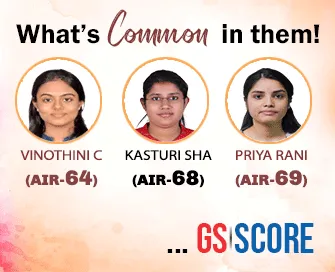

6th September 2023 (9 Topics)
Editorials
Context:
The Supreme Court heard the rejoinder arguments of senior advocates on the concluding day of the hearing on constitutional challenges against Article 370, which went on for 16 days.
Supreme Court's Decision
- Submission Opportunity: The Supreme Court has provided an opportunity for lawyers representing petitioners and respondents in the cases related to Article 370's removal and the Jammu and Kashmir Reorganisation Act, 2019 to present their arguments in writing.
- Page Limit: The submissions must adhere to a strict page limit, not exceeding two pages, ensuring brevity and focus in the legal arguments presented.
- Time Frame: Lawyers are required to submit these written arguments within the next three days, indicating a prompt and efficient process in addressing the legal challenges surrounding these critical issues.
Issues Discussed in Court
- Constitutionality of Article 370 Removal: The Attorney General and Solicitor General, engaged in a legal debate over the constitutionality of the government's decision to revoke Article 370.
- Validity of Jammu and Kashmir Reorganisation Act, 2019: The focus was on determining whether this act, which led to the bifurcation of the region into two Union Territories, stood on solid legal ground and aligned with the Indian Constitution.
- Governor and President's Rule Imposition: Lawyers presented arguments regarding the legality and necessity of these interventions in the erstwhile state's governance. The court considered these issues as part of the broader legal context.
Ensuring Constitutional Interpretation
- Rejecting Emotional Interpretations: Mohd Akbar, a leader from the National Conference, emphasized the importance of avoiding emotional interpretations of the Indian Constitution.
- Unique History of Jammu and Kashmir: Unlike other princely states, Jammu and Kashmir was never required to sign a merger agreement with India, which set it apart in terms of its relationship with the Indian Union.
- Sovereignty of India Unchallenged: He argued that the state's distinct history and constitutional framework should be considered when evaluating its relationship with the rest of India, urging a more thoughtful and nuanced examination of the matter.


Editorials
Context:
RBI should carefully examine data on digital currencies to determine the way forward.
Global Trend in CBDC Development
- International Momentum: Nineteen G20 nations are in advanced stages of developing Central Bank Digital Currencies (CBDCs), marking a global shift toward digital currency.
- Pilot Projects and Launches: Twenty-one nations have launched CBDC pilot projects, with eleven having already introduced digital currencies, showcasing diverse modernization efforts in finance.
- India's Progressive Steps: The RBI joined the global trend by issuing a CBDC concept note and launched wholesale and retail pilot programs, demonstrating commitment to digital currency exploration in India.
RBI's CBDC Initiatives and Their Impact
- Pilot Expansion: RBI expands CBDC pilots to cities like Ahmedabad, Chandigarh, Guwahati, Hyderabad, Indore, and Kochi, gathering insights from diverse regions.
- Growing Retail Adoption: RBI's retail CBDC gains a million users, 2.6 lakh merchants, aiming for 10 lakh transactions per day, indicating rising popularity.
- Interoperability with UPI: RBI aims to enhance CBDC adoption by aligning it with the widely used Unified Payments Interface (UPI) infrastructure.
Benefits and Caution Surrounding CBDCs
- Operational Efficiency: CBDCs promise to reduce operational costs related to physical cash management, making financial transactions more efficient and cost-effective.
- Cross-Border Payment Improvements: CBDCs provide quick settlement, improving cross-border payments' cost-effectiveness and security, benefiting countries like India with significant remittance flows.
- Cautious Approach Required: CBDC's far-reaching impact on financial and monetary systems requires cautious progress. Thorough data analysis and prudent decision-making are crucial for success.


Editorials
Context:
As India grows into a higher-income nation with more organized businesses, the government will earn more money, so it must spend it wisely.
Expanding Taxpayer Base and Lower Tax Rates
- Growing Taxpayer Base: India has seen an increase in both direct and indirect tax payers, including individuals and companies, despite slower economic growth.
- Shift to Lower Taxes: The government's decision to lower tax rates, such as corporate tax and personal income tax, has contributed to a stable tax-to-GDP ratio.
- Formalization's Role: The formalization of the economy and simplified tax processes have discouraged tax evasion but not significantly boosted tax revenue.
Impact of Tax Cuts on Revenue
- Corporate Tax Reduction: Corporate tax rates were reduced from 30% to 22%, leading to a decline in the corporate tax-to-GDP ratio from 3.5% to around 3.1%.
- Personal Income Tax Changes: Tax rebates for individuals with taxable income up to Rs 5 lakh increased the tax-to-GDP ratio but also led to more individuals with zero tax liability.
- GST Rate Cuts: Despite a weighted average GST rate reduction from 14.4% to 11.6%, GST collections remained stable at 6.6% of GDP in 2022-23.
Fiscal Foundations Strengthening
- Future Revenue Potential: As India progresses towards upper-middle-income status with an expanding organized sector, tax revenue gains are expected to increase, providing more fiscal space.
- Caution against Overspending: While revenue growth offers opportunities for government spending, it's essential not to squander gains through excessive giveaways.
- Policy Considerations: Policymakers must strike a balance between lower tax rates and revenue requirements to sustain economic development.


Editorials
Context:
Recent floods in northern India raised alarms. This is an indication that Infrastructure development and needs in the hills cannot be the same as in the plains.
Concerns over Himalayan Region
- Flood Devastation: The Chief Justice suggested a study on the Himalayan region's carrying capacity amid the recent floods.
- Challenging Balance: Balancing rising population, infrastructure needs, and fragile geography in hill-stations and Himalayan States is complex.
- Past Challenges: Previous efforts to assess environmental impacts, like after the 2013 Uttarakhand floods, faced stakeholder resistance and limited impact.
Sustainable Development Challenges
- Long-Standing Proposal: Since 2020, guidelines on carrying capacity assessment were circulated to Himalayan States, but progress has been slow.
- Conflict between Development and Ecology: Recent incidents like land subsidence in Joshimath and unexpected floods in Himachal Pradesh highlight the conflict.
- Need for Sustainable Practices: Himalayan infrastructure must prioritize sustainability or designate no-go zones. Avoiding this issue is no longer an option.
Way forward
- Scientific Engagement: Collaborate with scientists, local communities, and policymakers to assess carrying capacity and plan sustainable development practices.
- Stringent Regulations: Enforce strict regulations on infrastructure projects in ecologically sensitive Himalayan areas, prioritizing safety and sustainability.
- Public Awareness: Raise awareness about the environmental risks and consequences of unchecked development, encouraging responsible decision-making and policy changes.



